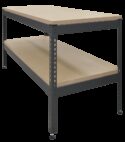Experiment
TD1360E
Cross-Flow Water-To-Air Heat Exchanger
Shows how cross-flow water to air heat exchangers work.
If you have any questions or you'd like to discuss a product, please call us.
+44 1159 722 611Cross-Flow Water-To-Air Heat Exchanger
This heat exchanger mimics those used in the process industry. It is similar to those used as a cooling radiator for combustion engines in automobiles, or in heating ducts for air-conditioning. It shows heat transfer by forcing air over a series of metal tubes through which water passes. As the air passes around the tubes, the heat present in the water transfers to the turbulent flow of air.
A fan with controllable air flow forces the air through a horizontal metal duct containing the metal tubes. Heated water from the service module passes through the metal tubes. The metal tubes are at right angles (90 degrees) to the air flow, creating a cross-flow heat exchanger. Metal plates or ‘fins’ surround the tubes, also at right angles to the air flow. These fins increase the effective surface area of the heat exchanger.
Thermocouples and an air flow sensor in the duct measure the air temperature and flow. Additional thermocouples measure the temperatures at the water inlet and outlet of the tubes.
The Heat Exchanger Service Module (TD1360V) provides heated water to the heat exchanger, and instruments needed to measure its performance. All fluid connections between the service module and the heat exchanger are self-sealing quick connectors – for safety and simplicity.
The heat exchanger is on a bedplate that has a clear schematic diagram showing the connections.
Learning outcomes
- Heat transfer from water to air.
- Introduction to the logarithmic mean temperature difference in heat exchangers.
- Effect of water temperature (the ‘driving force’).
- Effect of water and air flow rate.





